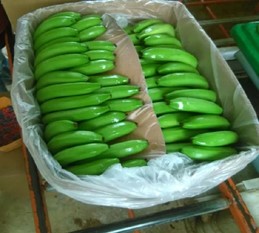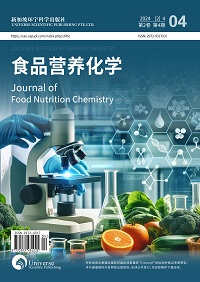探索非洲香蕉生产促进粮食安全和经济增长—简要综述
DOI:
https://doi.org/10.18686/zhfnc.v2i1.173关键词:
香蕉;生产;粮食安全;非洲;欧洲市场摘要
粮食危机是一个严重的全球性问题,但在非洲却更为明显,解决起来也更具挑战性。数百万非洲人饱受饥饿和营养不良之苦。粮食安全计划是人类生存的重要组成部分,而要实现这一点,就必须随时向人们提供营养和安全的食物。一个丰衣足食的社会不仅需要强有力的政策框架,还需要进行体制改革,以促进生产并使农业对年轻人更具吸引力。在此背景下,香蕉作物的可持续生产可在非洲粮食安全和促进经济增长方面发挥关键作用。香蕉在全世界人类营养中占有重要地位,是许多人食用的主食水果。香蕉是矿物质、维生素和碳水化合物的储存库,被视为能量储备。它通过出口获得外汇收入的前景广阔。随着非洲人口的持续增长,粮食需求也随之增加,这就要求对其农业生产系统进行彻底改革。可以利用土地和人力资本资源。据估计,非洲用于香蕉生产的可耕地面积约为5000万公顷,超过60%的人口年龄在25岁以下。非洲可以通过大量生产香蕉来满足当地需求和出口,从而建立一个体面的社会,摆脱饥饿的负担,实现经济繁荣。如果利用得当,香蕉作为粮食安全和经济繁荣的良方具有巨大的潜力。

##submission.downloads##
已出版
文章引用
期
栏目
执照
版权声明
CC BY-NC 4.0作者应保留其作品的版权,并授予期刊/出版商首次出版该作品的权利,同时根据以下条款获得许可: 知识共享署名-非商业性4.0国际版(CC BY-NC 4.0)。本许可证允许复制、分发和传播作品,前提是声明了原创作者的正确归属。
参考
1. Aderibigbe OR, Ezekiel OO, Owolade SO, et al. Exploring the potentials of underutilized grain amaranth (Amaranthus spp.) along the value chain for food and nutrition security: A review. Critical Reviews in Food Science and Nutrition. 2020; 62(3): 656-669. doi: 10.1080/10408398.2020.1825323
2. Food and Agriculture Organization of the United Nations. The State of Food Security and Nutrition in the World 2022. Available online: https://www.fao.org/documents/card/en?details=cc0639en (accessed on 19 April 2024).
3. African Development Bank Group. AfDB launches “Feed Africa: A Strategy for Agricultural Transformation in Africa 2016-2025”. Available online: https://www.afdb.org/en/news-and-events/afdb-launches-feed-africa-a-strategy-for-agricultural-transformation-in-africa-2016-2025-16122 (accessed on 5 May 2023).
4. Dotto J, Matemu AO, Ndakidemi PA. Potential of cooking bananas in addressing food security in East Africa. International Journal of Biosciences. 2018; 278-294. doi: 10.12692/ijb/13.4.278-294
5. Alemu MM. Banana as a Cash Crop and Its Food Security and Socioeconomic Contribution: The Case of Southern Ethiopia, Arba Minch. Journal of Environmental Protection. 2017; 08(03): 319-329. doi: 10.4236/jep.2017.83024
6. Aurore G, Parfait B, Fahrasmane L. Bananas, raw materials for making processed food products. Trends in Food Science & Technology. 2009; 20(2): 78-91. doi: 10.1016/j.tifs.2008.10.003
7. Perrier X, De Langhe E, Donohue M, et al. Multidisciplinary perspectives on banana ( Musa spp.) domestication. Proceedings of the National Academy of Sciences. 2011; 108(28): 11311-11318. doi: 10.1073/pnas.1102001108
8. Shahbandeh M. Leading producers of bananas worldwide in 2022, by country (in thousand metric tons). Available online: https://www.statista.com/statistics/811243/leading-banana-producing-countries/ (accessed on 19 April 2024).
9. Yang J, Tu J, Liu H, et al. Identification of an immunostimulatory polysaccharide in banana. Food Chemistry. 2019; 277: 46-53. doi: 10.1016/j.foodchem.2018.10.043
10. Zahra F, Khalid S, Aslam M, Sharmeen Z. Health benefits of banana (Musa)—A review study. International Journal of Biosciences (IJB). 2021; 18(4): 189-199. doi: 10.12692/ijb/18.4.189-199
11. Mondal A, Banerjee S, Bose S, et al. Cancer Preventive and Therapeutic Potential of Banana and Its Bioactive Constituents: A Systematic, Comprehensive, and Mechanistic Review. Frontiers in Oncology. 2021; 11. doi: 10.3389/fonc.2021.697143
12. Zafar IM, Saleha A, Hoque MME, Sohel RM. Antimicrobial and cytotoxic properties of different extracts of Musa sapientum L. subsp. sylvestris. International Research Journal of Pharmacy. 2011; 2(8): 62-65.
13. Hernández-Ruiz Á, García-Villanova B, Guerra-Hernández E, et al. A Review of A Priori Defined Oxidative Balance Scores Relative to Their Components and Impact on Health Outcomes. Nutrients. 2019; 11(4): 774. doi: 10.3390/nu11040774
14. Qusti SY, Abo-Khatwa AN, Lahwa MA. Free radical scavenging enzymes of fruit plant species cited in the Holy Quran. World Applied Sciences Journal. 2010; 9(3): 338-344.
15. Reinisalo M, Kårlund A, Koskela A, et al. Polyphenol Stilbenes: Molecular Mechanisms of Defence against Oxidative Stress and Aging-Related Diseases. Oxidative Medicine and Cellular Longevity. 2015; 2015: 1-24. doi: 10.1155/2015/340520
16. World Health Organization. A global brief on hypertension : silent killer, global public health crisis: World Health Day 2013. Available online: https ://www.who.int/cardiovascular_ diseases/publications /global_brief_hypertension/en/ (accessed on 19 April 2024).
17. Juraschek SP, Miller ER, Weaver CM, et al. Effects of Sodium Reduction and the DASH Diet in Relation to Baseline Blood Pressure. Journal of the American College of Cardiology. 2017; 70(23): 2841-2848. doi: 10.1016/j.jacc.2017.10.011
18. Anindyah DS, Farmawati A. Raja Bandung Banana (Musa paradisiacaL.cv Raja Bandung) Prevents Increased Systolic Blood Pressure in Rats Given Acute Stress Test. International Journal of Public Health Science (IJPHS). 2015; 4(1): 37. doi: 10.11591/ijphs.v4i1
19. Kamyab R, Namdar H, Torbati M, et al. Medicinal Plants in the Treatment of Hypertension: A Review. Advanced Pharmaceutical Bulletin. 2020; 11(4): 601-617. doi: 10.34172/apb.2021.090
20. Kritsi E, Tsiaka T, Sotiroudis G, et al. Potential Health Benefits of Banana Phenolic Content during Ripening by Implementing Analytical and In Silico Techniques. Life. 2023; 13(2): 332. doi: 10.3390/life13020332
21. Chrisanto EY. Effectiveness of Ambon Bananas in Reducing Blood Pressure in Hypertension Sufferers in the Work Area of Krui Health Center, Pesisir Barat Regency. Jurnal Kesehatan Holistik (The Journal of Holistic Healthcare). 2017; 11(3): 167-174.
22. Lopes MB, Rajasekaran R, Lopes Cançado ACF, et al. In vivo Confocal Raman Spectroscopic Analysis of the Effects of Infrared Radiation in the Human Skin Dermis, 2017 (Indonesian). Photochemistry and Photobiology. 2017; 93(2): 613-618. doi: 10.1111/php.12701
23. Hwang E, Park SY, Sun ZW, et al. The Protective Effects of Fucosterol Against Skin Damage in UVB-Irradiated Human Dermal Fibroblasts. Marine Biotechnology. 2013; 16(3): 361-370. doi: 10.1007/s10126-013-9554-8
24. Zafar IM, Saleha A, Hoque MME, Sohel RM. Antimicrobial and cytotoxic properties of different extracts of Musa sapientum L. subsp. sylvestris. International Research Journal of Pharmacy. 2011; 2(8): 62-65.
25. Shruthi D. Medicinal uses of banana (Musa paradisiaca). Drug Invention Today. 2019; 12(1).
26. Rodríguez-Ambriz SL, Islas-Hernández JJ, Agama-Acevedo E, et al. Characterization of a fibre-rich powder prepared by liquefaction of unripe banana flour. Food Chemistry. 2008; 107(4): 1515-1521. doi: 10.1016/j.foodchem.2007.10.007
27. Affognon H, Mutungi C, Sanginga P, et al. Unpacking Postharvest Losses in Sub-Saharan Africa: A Meta-Analysis. World Development. 2015; 66: 49-68. doi: 10.1016/j.worlddev.2014.08.002
28. Mashau ME, Moyane JN, Jideani IA. Assessment of post harvest losses of fruits at Tshakhuma fruit market in Limpopo Province, South Africa. African Journal of Agriculture Research. 2012; 7(29): 4145-4150. doi: 10.5897/AJAR12.392
29. Menezes EW, Tadini CC, Tribess TB, et al. Chemical composition and nutritional value of unripe banana flour (Musa acuminata, var. Nanicão). Plant Foods for Human Nutrition. 2011; 66: 231–237. doi: 10.1007/s11130-011-0238-0
30. Murmu SB, Mishra HN. Measurement and modelling the effect of temperature, relative humidity and storage duration on the transpiration rate of three banana cultivars. Scientia Horticulturae. 2016; 209: 124-131. doi: 10.1016/j.scienta.2016.06.011
31. Yang X, Zhang Z, Joyce D, et al. Characterization of chlorophyll degradation in banana and plantain during ripening at high temperature. Food Chemistry. 2009; 114(2): 383-390. doi: 10.1016/j.foodchem.2008.06.006
32. Sarah S, Bornare DT, Ayesha S. Process Optimization for making unripe banana flour and its utilization in vermicelli. International Journal of Advance Scientific Research and Engineering Trends. 2017; 2(10): 229-237.
33. Dodo MK. Examining the potential impacts of climate change on international security: EU-Africa partnership on climate change. SpringerPlus. 2014; 3: 194. doi: 10.1186/2193-1801-3-194
34. Jayathilakan K, Sultana K, Radhakrishna K, Bawa AS. Utilization of byproducts and waste materials from meat, poultry and fish processing industries: A review. Journal of Food Science and Technology. 2011; 49(3): 278-293. doi: 10.1007/s13197-011-0290-7
35. Bornare PP, Deshmukh DS, Talele DC. Recent trends in banana by-products and marketing strategies: A critical review. International Journal of Science, Spirituality, Business and Technology. 2014; 3(1): 2277-7261.
36. Guiné RPF. The drying of foods and its effect on the physical-chemical, sensorial and nutritional properties. International Journal of Food Engineering. 2018; 4(2): 93-100. doi: 10.18178/ijfe.4.2.93-100
37. Razali SA, Mohd Nor MZ, Anuar MS, et al. Banana Powder Production via Foam Mat Drying. Advances in Agricultural and Food Research Journal. Published online December 16, 2020. doi: 10.36877/aafrj.a0000142
38. Yang G, Wang J, Cheng Y, et al. Banana powder: Functions current status and new technology on processing. International Journal of Food Science and Biotechnology. 2007; 26(5): 121-126.
39. Rappert S, Müller R. Odor compounds in waste gas emissions from agricultural operations and food industries. Waste Management. 2005; 25(9): 887-907. doi: 10.1016/j.wasman.2005.07.008
40. Gigot C, Ongena M, Fauconnier M, et al. The lipoxygenase metabolic pathway in plants: potential for industrial production of natural green leaf volatiles. Biotechnologie, Agronomie, Société et Environnement. 2010; 14: 451-460.
41. Falade KO, Ogundele OM, Ogunshe AO, et al. Physico-chemical, sensory and microbiological characteristics of plain yoghurt from bambara groundnut (Vigna subterranea) and soybeans (Glycine max). Journal of Food Science and Technology. 2014; 52(9): 5858–5865. doi: 10.1007/s13197-014-1657-3
42. Owolade SO, Egbekunle KO, Awe OFE, et al. Effect of three different varieties of banana inclusion on nutritional and sensory acceptability of yogurt. African Journal of Biological Sciences. 2022; 4(2): 96-105. doi: 10.33472/AFJBS.4.2.2022.96-105


